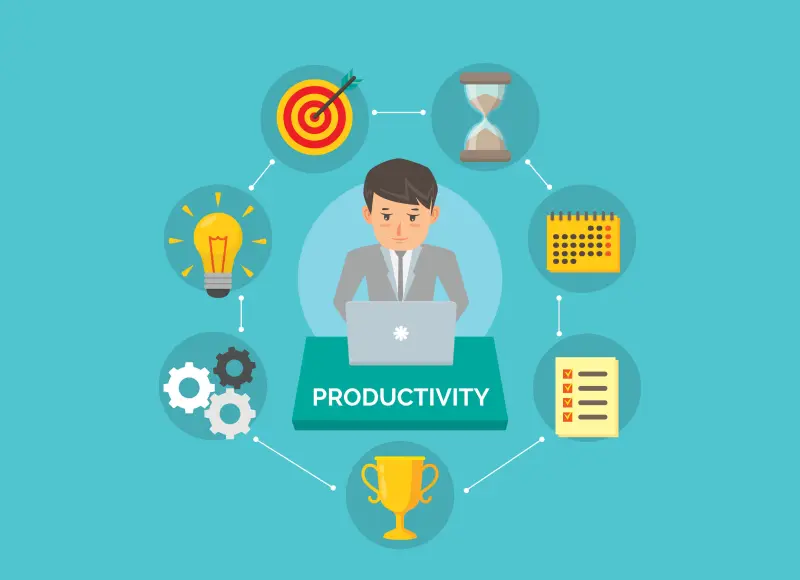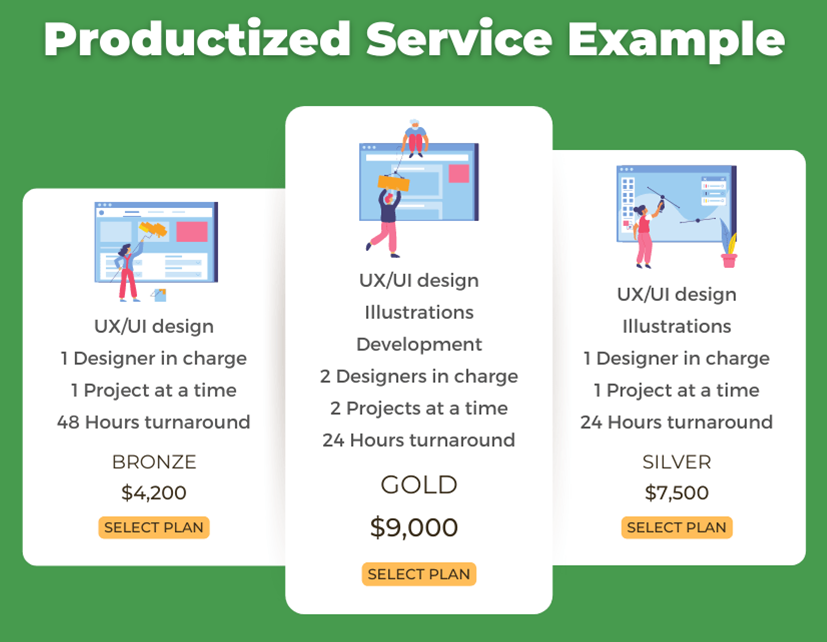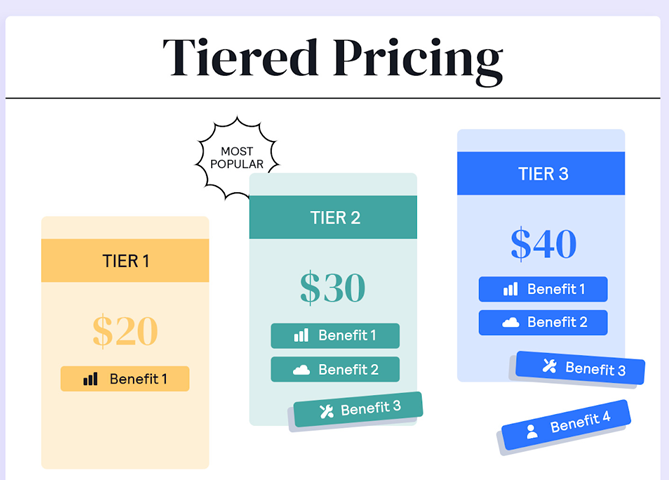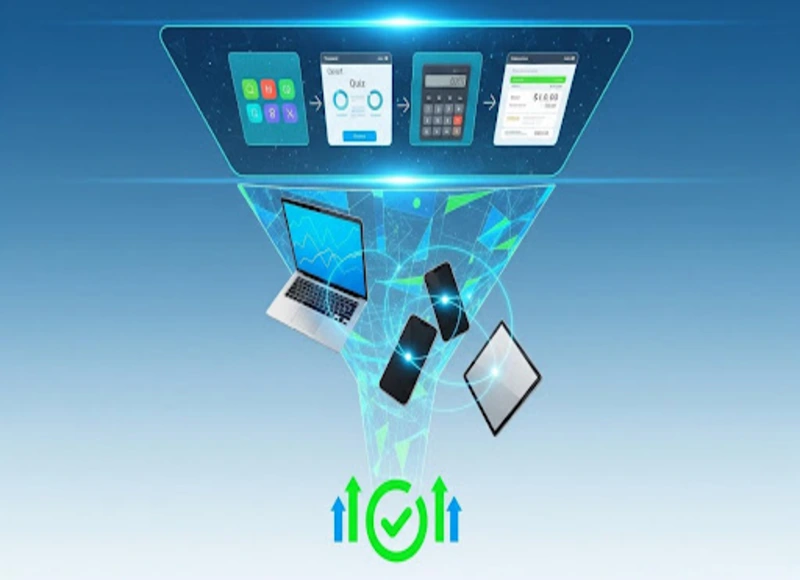Table of Contents
Learn how to set prices for your productized services with these 5 essential tips from industry professionals.

A top-tier software company leader periodically reviews the nuances of pricing strategies. Because nailing a pricing strategy calls for a balancing act — too high and you risk losing potential customers; too low and you'll lose revenue.
There's a unique twist for productized services since they are essentially specialized solutions packaged as products. Here, you'll think of a service as a product with a price, just like a Software as a Service business.
And since you'd bill clients a fixed price and not on an hourly basis, the offerings should address specific problems. The upside is a simplified buying process for your clients and achieving predictable revenue streams for your business.
Pricing Tips for Productized Services
Selling productized services has a tangible outcome that needs a pricing approach reflecting value, not just time invested. Different pricing strategies have different impacts on your revenue and also on clients leveraging your services.
Service productization can have —
- Usage-based pricing: Customers are charged based on their actual usages of the product, such as the number of API calls, storage space utilized, or features accessed. With a model like usage-based pricing, the charges are aligned with consumption, offering flexibility for customers with different needs.
- Tiered pricing: This approach offers users different pricing tiers with features and functionalities catering to various customer segments.
- Flat-rate pricing: Here, you'd charge a single, flat rate for all the features and functionalities of your productized services to offer simplicity and predictability for customers.
Similarly, you'd choose from plenty of other pricing models when offering productized services.
Because 98% of SaaS businesses achieve favorable results by changing their pricing policy.
But here's the challenge: how do you price these services effectively? Striking the right balance is crucial. But how do you do that?
This is what we'll explore in this piece — key pricing tips to help find that sweet spot.
Let's begin.
Tip #1: Emphasize Value, Not Cost
Do not let cost dictate pricing. Productized services focus on delivering value to your clients in terms of the outcomes they achieve.
So, think of —
- Specific clients' problems your productized service solves.
- Time and resources your clients save.
- Potential revenue or cost savings that it can generate for your clients.
- Unique benefits your services provide.
For SaaS development, this might mean highlighting how your service improves efficiency, reduces costs, or enhances user experience.
Here's how to implement this approach effectively—
Quantify the Value
Translate your service benefits into quantifiable metrics so that potential clients can see the direct impact of your productized services on their business.
For example, if your onboarding services reduce churn by 15%, calculate the potential revenue retention (or generation) for a typical client. When negotiating, use this data to justify your price points.
Customer Testimonials and Case Studies
Gather and show customer testimonials who attest to the value your service provides to their businesses. Create and showcase compelling case studies that highlight real-world examples of how productized service has helped other companies achieve their goals.
Value-Based Pricing Tiers
Create pricing tiers based on the value each package delivers rather than simply on the features included. For instance, higher tiers may include more personalized support, advanced integrations, or additional consulting services tailored to clients' needs.
Tip #2. Regularly Review and Adjust
Pricing is a constant process. You cannot set one price and forget because of sustainability issues after a point. Hence, reviewing and adjusting your prices ensures they remain competitive and aligned with the value you provide.
Here's what you'll need to do.
Pricing isn't a set-it-and-forget-it endeavor. As your business evolves, so should your pricing strategy. Regularly review your pricing model to ensure it aligns with your current value proposition, market conditions, and customer feedback.
Schedule Regular Pricing Reviews
Set a recurring schedule (e.g., quarterly or annually) to reassess your pricing model. Analyze your sales data, customer feedback, and market trends to identify areas for improvement.
Track Key Performance Indicators (KPIs)
Monitor KPIs that are affected by pricing. For this, it is best to apply marketing reporting that tracks KPIs effectively, connects them to your MarTech platform, and alerts you in case of any deviations. For instance, customer acquisition cost (CAC), customer lifetime value (CLTV), and churn rate help gauge the effectiveness of your pricing strategy.
If you fail to hit the sweet pricing spot, the deviation-based alerts help refine the pricing strategies to achieve the desired results.
Communicate Pricing Changes Transparently
Once you decide (changes) on the prices, communicate the same clearly and transparently to your existing and potential customers. Also, in the case of tiered pricing, consider communicating a detailed breakdown of what each price tier includes.
This will let your clients see the value in higher-priced options and understand what they are paying for. Provide rationale behind the changes and highlight the additional value they can expect.
Tip #3: Stay Updated with Market Rates
Next, pricing your productized services requires positioning them effectively in the market. For this, consider creating a detailed competitor analysis report that includes pricing, service features, and perceived value.
Remember, you're offering a unique value proposition with your productized service. So, your pricing should reflect your expertise, brand reputation, and the specific outcomes you deliver.
Here's what you'd consider doing:
Research Pricing
Identify the different pricing models used by your competitors (e.g., subscription-based, tiered pricing, usage-based, etc.). Visit their website, check their social handles, and visit third-party sites to analyze their offerings and assess how they position their value proposition.
Value Differentiation
Based on the pricing research, identify the areas where your productized service stands out from the competition. Think about what you can offer. Better customer support, a proven track record (and experience) of delivering exceptional results, or something else. The unique selling points (USPs) of your service should be highlighted in your marketing and sales efforts to justify pricing.
Price Testing
Experiment with different price points to gauge customer response. Provide introductory discounts, limited-time offers, or different pricing tiers and see what works best amongst the target market. Monitor sales data and customer feedback to identify the optimal price point that boosts your revenue and drives customer satisfaction.
Tip #4. Implement Value-Based Tiered Pricing
Put up a tiered pricing model that caters to different client needs. Refrain from relying solely on the number of users or features. Instead, think of value-based pricing metrics aligning with the outcomes your clients seek. This could involve charging based on the number of leads generated, sales closed, or time saved.
For instance, a SaaS service helping businesses automate their customer support could charge based on the number of support tickets resolved or customer satisfaction ratings achieved.
Define Service Levels
Multiple service levels should offer different features and benefits. Here, each tier should offer clear and incremental value, making it easier for clients to choose the level that best suits their needs.
Here's an example of customer support automation service —
- Basic Tier: Includes automated responses for common queries and access to a basic knowledge base.
- Pro Tier: Adds AI-driven chatbots that address more complex queries and integration with third-party CRM systems.
- Premium Tier: This can involve dedicated support customization, advanced analytics, and personalized customer success management.
Identify Key Value Metrics
Know the most critical metrics that can directly impact the bottom line of your clients. These could be quantitative metrics like revenue generated, cost savings, or productivity gains, or qualitative metrics like customer satisfaction or brand awareness.
Demonstrate Upgrade Benefits
Show the benefits users can get by upgrading to higher tiers. Again, your sales collateral can emphasize what (and how) each tier provides additional value and solves more complex problems. For this, focus on showing case studies or testimonials from clients who benefited from higher-tier services. Also, include the ROI they achieved.
Tip #5. Collect and Analyze Customer Feedback
Ask customers for pricing feedback. Look for invaluable insights through surveys, interviews, or focus groups. This will help gauge your clients' perception of value, willingness to pay, and potential barriers to purchase.
The idea is to understand how your clients perceive the value and cost of your services. The feedback analysis will unlock invaluable insights for setting prices that resonate with your target market.
For this, you'd typically undertake the following activities.
Conduct Regular Surveys
Regular surveys help collect feedback from your clients about their satisfaction with your pricing and the value they receive. Utilizing NPS platforms can streamline this process and provide valuable insights into customer sentiment. A fundamental net promoter score (NPS) can be a good starter, and you can use this score throughout the communication. But go a step forward and ask specific questions about what they find most valuable and if they feel the pricing is fair.
For instance, post-service surveys can include asking clients about their experience and how they perceive the value relative to the cost. This requires designing a simple (yet comprehensive) survey covering service value, pricing fairness, and overall satisfaction.
Analyze Client's Feedback
Look for patterns or recurring themes in customer feedback to identify areas where you can improve your pricing strategy or messaging. The systematic feedback analysis helps discover common themes on what clients value most and any recurring suggestions or complaints about pricing.
This requires using spreadsheets or specialized feedback analysis software to analyze survey and interview data.
Over to You
Pricing productized services is the first step to ensure sustained profitability of your business. Try to emphasize providing the best services that add value. Blending some of the above tips can help find the sweet spot to maximize both client satisfaction and your profitability.
Once you set and implement pricing strategies, do not forget to keep updating the same, as you do not set the rates in stone. Remain open to experiment, adapt, and refine the pricing approach over time. The key is to focus on delivering excellent results and remaining confident, knowing that what you charge is worth every penny clients invest.
Recent Blogs
Key Benefits of Hiring Nearshore React.js Development Teams for Enterprise Projects
-
20 Jan 2026
-
10 Min
-
120
Stop Building from Scratch: Boost Your Marketing Funnel with App Templates
-
13 Jan 2026
-
10 Min
-
466









